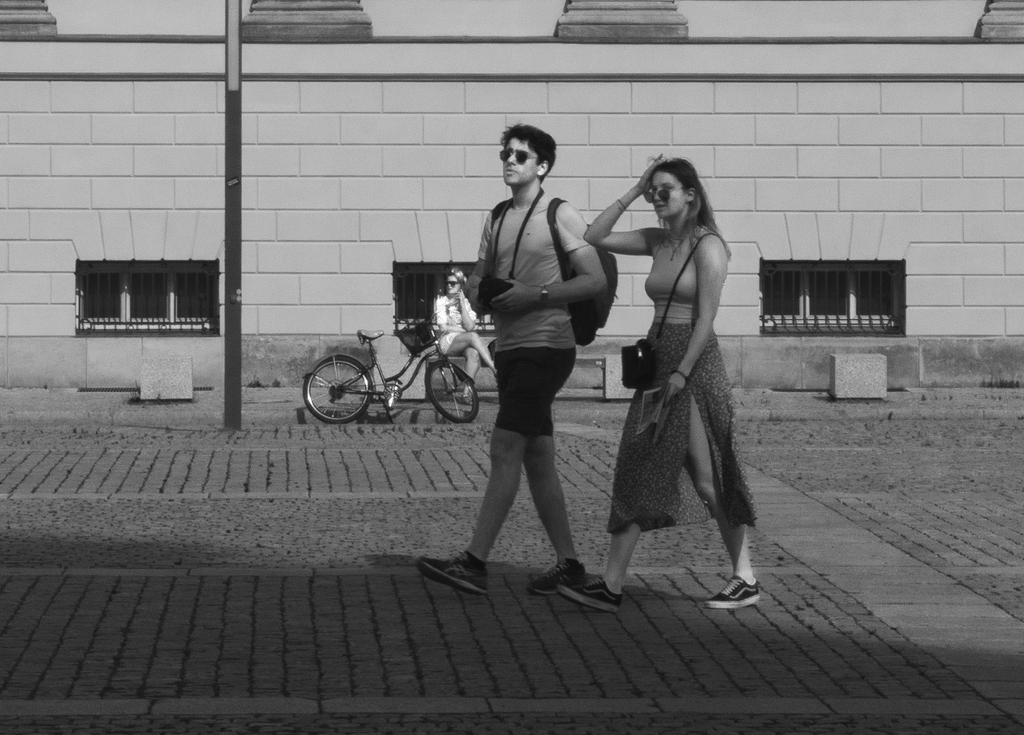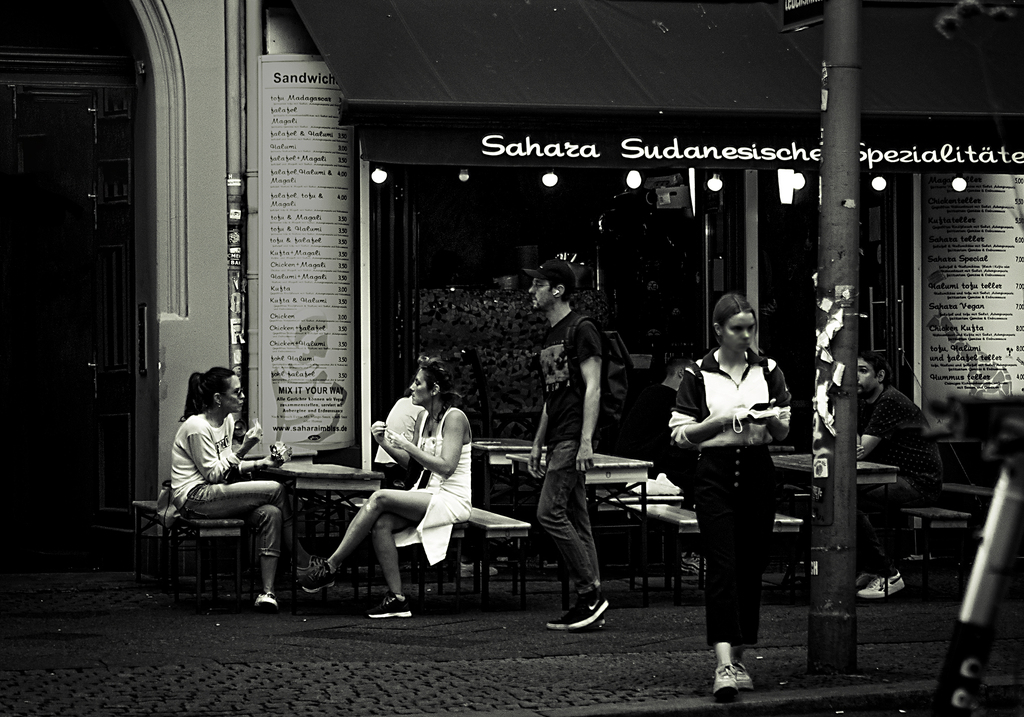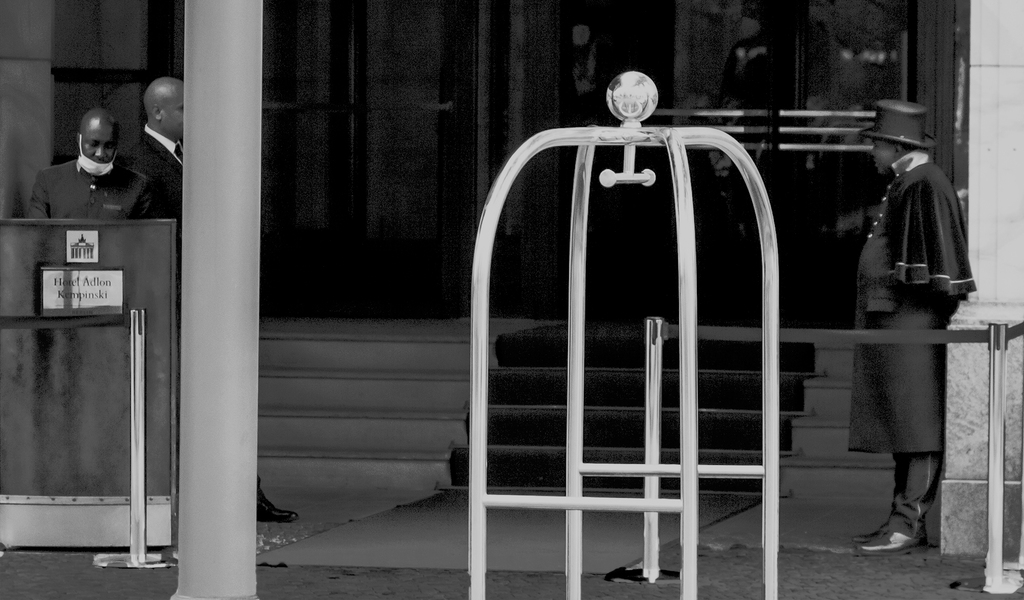Berlin’s urban streets reveal ever new ideas for urban street photographers, and regardless of the present laws about photographing people in public, and what people believe their rights to be, it is still possible to enjoy a stroll through Berlin with a camera in hand.
It is still perfectly legal to take photographs in a public place.
Thoughts on Berlin Street Photograph
The ground is sandy and pebbly, the light is bright but softly moves into a foreground shadow that creates something of a mood in the photo. There is a sparrow to the right of the photograph, and two white pieces of rubbish on the ground to the left. Everything involved, rubbish as well, creates an interesting composition.
These days there is a lot of talk about “narrative”, and “story”, in photography and other areas of society like business.
Narratives must be supported by a dialogue. Photos don’t express themselves in terms of dialogues.
A moment, a snap of time caught in a still moment. we enjoy many types of expression in art, one of them is writing, the other photography and visual art, they serve two distinctly different ways of interpreting the world.
So when people talk about narrative in a photograph, they aren’t talking about photographs that tell stories, they are inventing something for themselves, and hoping that the viewer will also invent a narrative. A photographer has no control over what the viewer thinks or feels when they look at a photo. A writer does have this control, a writer leads a reader along with a narrative that gives guidance to a story that is supported by a logical plot.
There is no narrative caught by the camera.
When you look at the photograph you see the basics of what most other people see, any narrative that develops in your mind is purely fictional. You invent the narrative because the photograph helps you to begin thinking about a particular element that you see in the photograph.
Urban Street photography is about capturing a moment in time. When I walk around the streets of Berlin with a camera I want to see something that interests me, something that will prompt me to take a shot.

Fast Shutter and Quick Moving people
I’ve already set my camera with a fairly fast shutter speed so that I don’t fluff the moment if people are moving, I have compensated with a notch up on the ISO to ensure I get enough light into the camera, and I want to be in an F Stop zone that helps me focus with depth and pick up details to support the composition.
With the Coronavirus Covid 19 epidemic affecting all of us at the moment, going outside and walking is interesting.
We know that we should social distance from each other, for a while it was no more than two people together. No hanging around on benches and so on.
The Streets have become Different to Look at
In Berlin things have relaxed a little and its now possible to see groups of people moving about together, individuals, and couples keeping their distance.
All of this gives us a lot to reflect on. Things are different, we don’t see or look for the familiar sights. Assemblies, bars full, and people spilling out into the street, busses pulling up at a stop hissing doors slide open to allow strings of people to pile out into the street, bumping into each while some stop to get their bearings and others rush through the small crowd to be someplace more quickly than their feet can move. This is a good place to for a street photographer to stop and look, watching for a composition that offers a challenge with light and shadows, or the possibility of an interaction between strangers that would make an interesting image to keep. Daily life.
This isn’t happening right now. People are cautiously wandering around parks, sitting on benches alone, and standing on street corners drinking a beer together, instead of in a bars where they might have spent hours of their lives chatting and rubbing shoulders with crowds of other guests.
Now, we see people dodging each other, that creates compositions that are unusual.

A photo of two men walking through a tunnel, they appear to be arm in arm, or they are nudging each other as they walk, as if they are joking with each other. That’s a thought that the photo prompts in my mind.
One of them is wearing shorts and training shoes, the other is in long dark trousers.
I like the image because the white shirts allowed me to play with the light, and pick out the folds in their shirts.
The small metal street sign that blocks half of their bodies, creates a further play of light and darkness that breaks up the white reflections.
The digital side of things is that the photo is not “tack Sharp”, and the whole idea is about the image itself being interesting to look at. It isn’t a technically perfect photograph that proves the power of a lens, or the megapixel strength of a camera. It is a photo worth looking at.
I see a lot of photos on the internet that are irritating. They are shots taken with high powered lenses that cost a fortune, the camera is probably 105 Megapixels, and the person behind the lens is expecting that the amazing technology, the smooth colours, the lit up faces, the lack of noise in the photo, will be enough to deem it a good photo. Everybody must say Wow!
Photographers must Work with an Attitude of Intent
Photography is a skill that involves many components. The photographer spends a lifetime learning about these skills, trying many different ways of taking a photo, understanding that each shot taken – on the street, or in a studio can be manipulated through the lens by controlling the light and darkness of an image.
Walking through the streets of Berlin, taking shots of structures, people, groups, and slightly interesting subjects, is a small journey along the way to becoming a good photographer.
To walk and look with expectations, intentions helps a lot. If you walk out into Berlin and know what you are looking for, you’ll start to see shapes and forms that correspond with your intentions as a photographer.
Groups of people form and disperse quickly, couples walking through a park act differently to couples out shopping.
A single figure waiting at a bus stop or another in a doorway have different intentions, and therefore express a different body language.
A single figure just stepping onto the stairway in the underground, the train pulling out, the next coming down the tunnel, creates a vacuum for a small moment. Then the wind gushes through the station causing light cotton shirts to wrap around bodies, coats and jackets flip upwards, hair flaps into faces, hat brims bend, and hands hold tightly onto bags and baseball caps. People climb the stairs as if they are in a force ten gale, struggling to make their way up the thirteen steps without losing anything valuable, and to keep their footing.
A street photographer can predict this happening in some of the underground stations of urban Berlin.

If you work with intentions you will put yourself in a position of being able to predict what will happen, or what might happen in certain locations.
Stand close to the exit of a large shopping mall, and you might find a few smiling faces, people sharing their new purchase with their friends. people stopping and checking their mobile phones, frowns, smiles, laughter, and confusion are a part of shopping.
Outside a train station you can often see people meeting each other. They haven’t spoken or touched each other in weeks, months or longer. Their reactions are special moments that can be captured. Human nature expresses itself everyday on the streets of Berlin.
Just be sure that you create compositions of street scenes, and not a portrait of an individual. The law rules the streets, and a street photographer can still freely photograph the throngs and masses without fear of legal action.
When an individual becomes the centre of attention in your photograph, and you don’t have written permission, you risk prosecution without a leg to stand on.
A group of strangers who are in your composition, a street, an object like a building, shops and offices, is a composition. If an individual is removed, the composition still works, the person was not integral to the photo.
Having strong intentions about what type of photos we want to capture when you take a jaunt into the crowds, helps tremendously when you hope to come back with some good shots.
Experiment all of the Time, that’s how to Produce Work
Everything we do is an experiment, so every shot should be a moment of trust in yourself that you saw something worthwhile, and took the shot. You’ll know later whether you were right or not.
All artist are the same when it comes to the validity of their work. You can only know if something, your efforts and ideas, are of value after you finish the work. So street photography is often a hit and miss game of trying out ideas, pushing the limits of compositions, tweaking the dials to get more light, or lower the shadows.
Learning to look at a scene as a whole, and then quickly disseminate it in your mind is a skill that a photographer must practice. It’ll pay off in time, and it’s a pleasant way to work with decisive thinking, instead of being two minded about everything you look at.
If you take photos for any reason and want to process them properly and efficiently, I recommend experimenting with Photoshop by Adobe as a post processing tool. It’s an eye opener to the possibilities of digital photography, as well as understanding your own intentions with digital photography.
Leave a Reply
You must be logged in to post a comment.